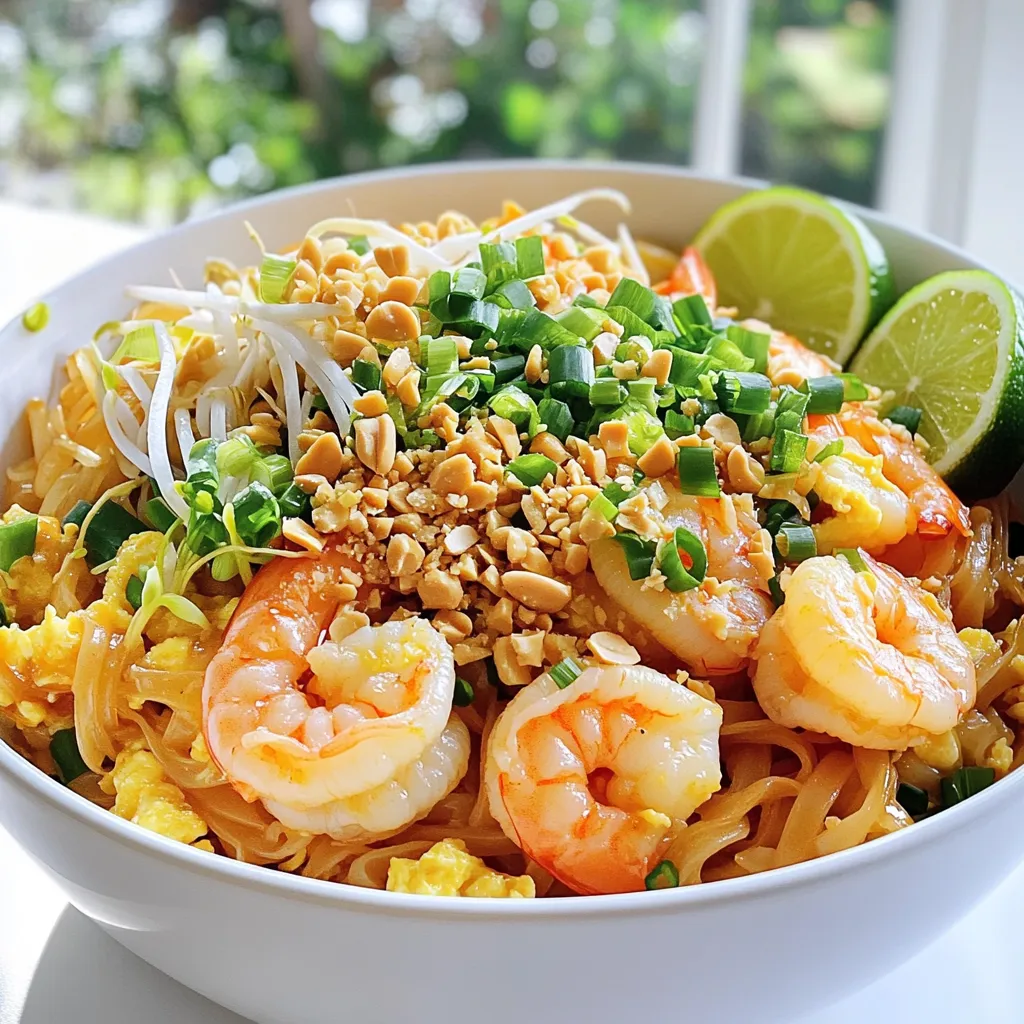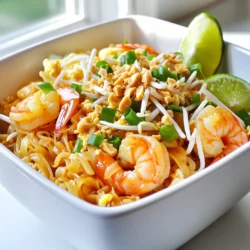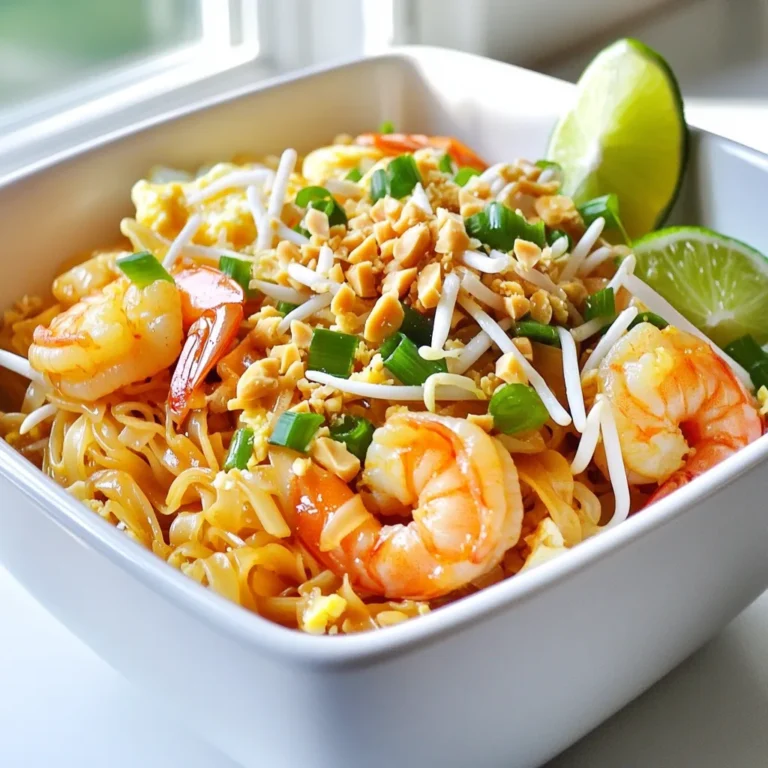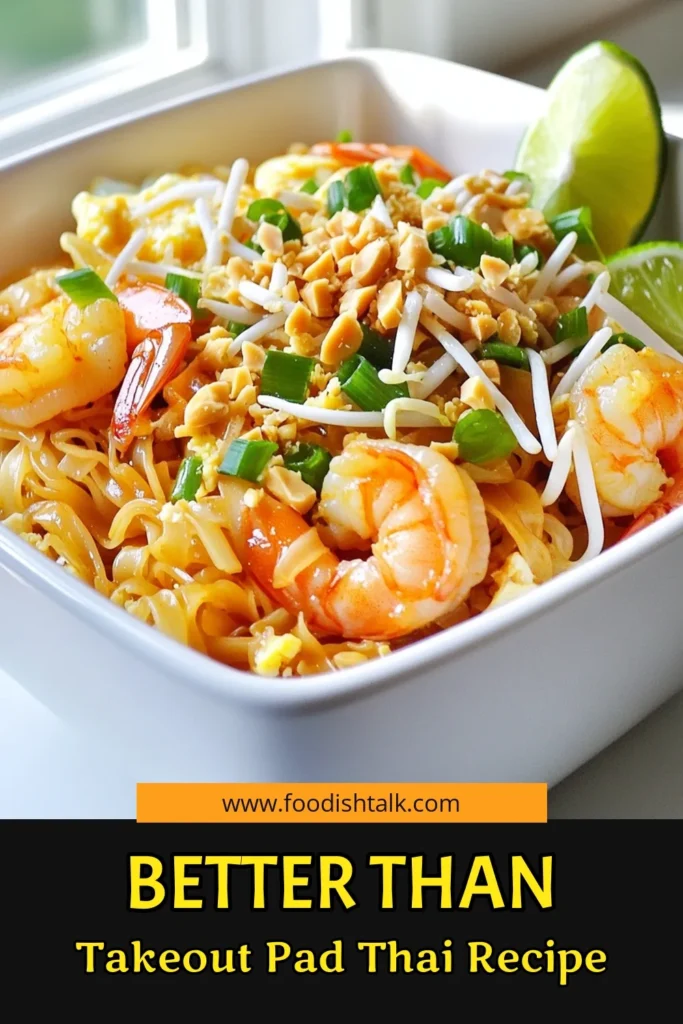Craving something delicious yet easy to make? You’re in the right place! This Better Than Takeout Pad Thai recipe delivers bold flavors using simple ingredients. With step-by-step instructions, I’ll guide you through each phase, whether you prefer shrimp, chicken, or tofu. Plus, I’ll share tips for authentic taste and ways to make it your own. Let’s transform your kitchen into a gourmet Thai restaurant tonight!
Ingredients
List of Ingredients
– 8 ounces rice noodles
– 2 tablespoons vegetable oil
– 3 cloves garlic, minced
– 1 cup cooked shrimp (or chicken/tofu if preferred)
– 2 eggs, lightly beaten
– 1 cup bean sprouts
– 4 green onions, chopped
– 1/4 cup crushed peanuts
– 1/4 cup fresh cilantro, chopped
– 3 tablespoons soy sauce
– 1 tablespoon tamarind paste (or lime juice)
– 1 tablespoon brown sugar
– 1 teaspoon red pepper flakes (adjust to taste)
– Salt to taste
– Lime wedges for serving
Ingredient Substitutions
You can switch up proteins to suit your needs. Use chicken, tofu, or shrimp. If you want it vegan, use tofu instead of shrimp or chicken. For gluten-free Pad Thai, choose rice noodles made without wheat. If you can’t find tamarind paste, use lime juice for a similar tang.
Best Ingredient Sources
Fresh ingredients are key for great taste. Look for rice noodles at Asian markets or online. Choose noodles that are thin and pliable. For proteins, buy shrimp or chicken from a reliable source. Always check for freshness. Look for firm shrimp and vibrant green onions. Fresh cilantro adds life to your meal.
Step-by-Step Instructions
Preparing the Rice Noodles
To start, soak the rice noodles in hot water for 30 minutes. This helps soften them. If the package says a different time, follow that. After they are soft, drain them in a colander and set them aside.
Cooking the Shrimp and Eggs
In a large skillet or wok, heat 2 tablespoons of vegetable oil over medium-high heat. Add 3 cloves of minced garlic and sauté for 30 seconds. This makes the kitchen smell great! Next, add 1 cup of cooked shrimp (or chicken/tofu if you like). Stir-fry for 2-3 minutes until they are warm.
Now, push the shrimp to one side of the pan. Pour 2 lightly beaten eggs into the other side. Scramble the eggs until they are fully cooked. Once done, mix the eggs with the shrimp.
Combining Everything
Now it’s time to add flavor! Add the soaked rice noodles to the pan. Pour in 3 tablespoons of soy sauce, 1 tablespoon of tamarind paste (or lime juice), 1 tablespoon of brown sugar, and 1 teaspoon of red pepper flakes. Toss everything well. You want the noodles to soak up all the sauce.
Next, stir in 1 cup of bean sprouts and half of the chopped green onions. Cook for 2 more minutes until everything is hot. Taste your dish. If it needs more flavor, add a pinch of salt or some soy sauce.
Once it’s ready, take it off the heat. Garnish with 1/4 cup of crushed peanuts, 1/4 cup of fresh cilantro, and the rest of the green onions. Serve your Pad Thai right away with lime wedges on the side for a zesty kick!
Tips & Tricks
Achieving Authentic Flavor
To make your Pad Thai taste like it came from a restaurant, focus on these key points:
– Use fresh ingredients. Fresh garlic, herbs, and proteins bring great taste.
– Tamarind paste is essential. It gives Pad Thai its tangy flavor. If you can’t find it, lime juice works too.
– Balance sweet and salty. Use brown sugar and soy sauce to create depth in flavor.
These steps will make your dish stand out. The right mix of flavors creates a dish that sings.
Cooking Techniques for Pad Thai
When cooking Pad Thai, the right technique matters. Here are essential tips:
– Wok vs. Skillet: A wok allows for high heat and quick cooking. Use a skillet if you don’t have one, but adjust the heat carefully.
– Heat levels: Start at medium-high heat. This helps ingredients cook fast without burning.
– Timing is key: Don’t overcook your shrimp or veggies. They should be tender yet crisp.
By mastering these techniques, your Pad Thai will shine.
Common Mistakes to Avoid
Avoid these common mistakes that can ruin your Pad Thai:
– Overcooking ingredients: This makes them mushy. Keep your shrimp and veggies crisp.
– Imbalance of flavors: Too much soy sauce can make it salty. Taste as you go.
– Skipping garnishes: Peanuts and cilantro add flavor and texture. Don’t leave them out!
Steering clear of these errors will help you create a perfect dish every time.

Variations
Vegetarian & Vegan Options
You can easily make a plant-based Pad Thai. Start by swapping shrimp or chicken for tofu. Firm tofu works best. Press it to remove excess water, then cut it into cubes. Sauté the tofu until golden brown. Use soy sauce and tamarind paste for flavor. For a fresh twist, add more veggies like bell peppers or mushrooms. Flip in extra bean sprouts and chopped carrots for crunch. This keeps your meal colorful and healthy.
Protein Variations
Pad Thai works with many proteins. You can use shrimp, chicken, or tofu. If you choose shrimp, cook them until pink. For chicken, slice it thin and stir-fry until cooked. Tofu is great for a vegan option. It soaks up flavors well. You can also mix proteins, like using shrimp and chicken together. This adds layers of taste and texture.
Spicing it Up
Adjust the heat to fit your taste. Start with one teaspoon of red pepper flakes. If you want it spicier, add more. You can also try fresh chili peppers for a kick. A touch of sriracha sauce can enhance the flavor too. Balance the spice with lime juice, which adds brightness. This lets you create a Pad Thai that’s just right for you.
Storage Info
Storing Leftovers
To keep your Pad Thai fresh, store leftovers in an airtight container. Place it in the fridge within two hours of cooking. If you want to keep it longer, freeze it. Make sure to use a freezer-safe container. When you freeze Pad Thai, it stays good for up to three months.
Reheating Instructions
For the best texture and flavor, reheat Pad Thai in a skillet. Add a splash of water or oil to keep it moist. Heat over medium-low, stirring often. This method helps prevent the noodles from becoming too hard or sticky. You can also use the microwave. Heat it in short bursts, stirring in between to ensure even warming.
Shelf Life
Leftover Pad Thai can last in the fridge for about three to four days. Always check for any off smells or changes in texture before eating. If you freeze it, just remember to label your container. This way, you can keep track of when you made it.
FAQs
Can I make Pad Thai ahead of time?
Yes, you can make Pad Thai ahead of time. If you plan to meal prep, cook your noodles and protein first. Store them separately. This keeps them from getting soggy. When ready to eat, just heat them up. Add the sauce and fresh veggies right before serving. This way, your Pad Thai stays fresh and tasty.
What is tamarind paste and can I substitute it?
Tamarind paste is a thick, tangy paste made from tamarind fruit. It adds a unique sweet and sour flavor to Pad Thai. If you don’t have tamarind paste, you can use lime juice. Lime juice gives a bright, zesty taste. You might also try a mix of brown sugar and vinegar for a similar effect. Each option will change the flavor a bit, but they can work well.
How do I make Pad Thai gluten-free?
To make Pad Thai gluten-free, use gluten-free soy sauce. Look for brands made from rice or tamari. You also need to check your rice noodles. Most are gluten-free, but always read labels. If you want a twist, try zucchini noodles. They add a fun texture and keep it light. Enjoy your gluten-free Pad Thai without worry!
This blog post guides you through making great Pad Thai at home. We covered key ingredients, cooking methods, and tips for authentic flavors. We also discussed variations, storage, and common questions.
As you cook, remember that practice makes perfect. Don’t hesitate to adjust flavors to match your taste. Enjoy creating your own delicious version of this classic dish. Happy cooking!



